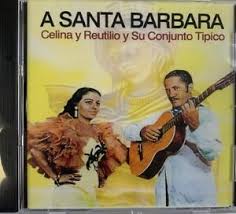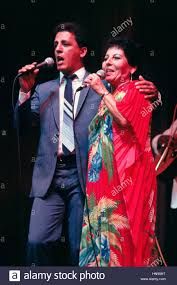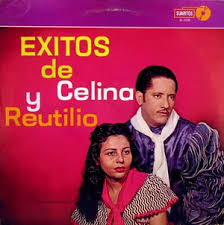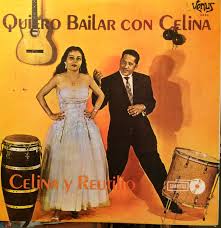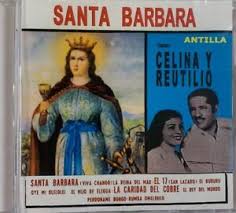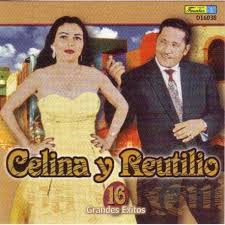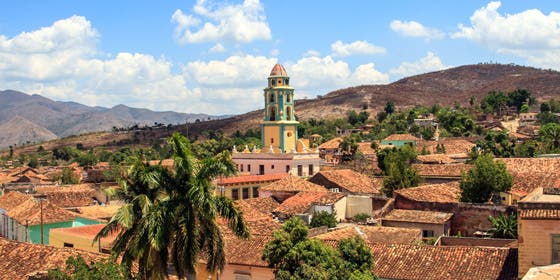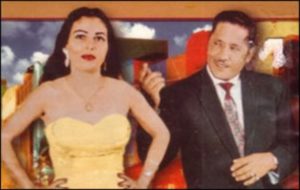
CELINA GONZÁLEZ, “LA REINA DE LA MÚSICA GUAJIRA CUBANA”. “CELINA Y REUTILIO”. PHOTOS/VIDEOS.
Celina González Zamora fue una cantautora cubana, especializada en “música campesina”, música tradicional del campo cubano.
De padres campesinos, cuando Celina era niña, sus padres y hermanos cantaban en los saraos familiares de fin de semana. Ángela, tocando el tres y cantando y Jesús, el laúd. Celina aprende la base melódica y rítmica del cante guajiro, y de su madre la devoción, por las religiones criollas de Cuba, y de los orishas: Ochún, Babalú Ayé, Changó y Yemayá.
Durante su infancia, su familia mudó a Santiago de Cuba. Gracias a la radio y a su predilección por el sonido punto cubano comenzó a improvisar alguna que otra décima y cuarteta, hacia 1943 conoce al que va a ser el amor de su vida, Reutilio.
https://youtu.be/Y06C82oAz9o
Presione ^ Aqui
CELINA Y REUTILIO CANTAN
El dúo se hace conocido en Santiago de Cuba. Finalmente, en 1947 hacen su debut en una emisora de radio, la CMKR.
DUO DE CELINA Y REUTILIO
Es mejor conocida por ser coautora de A Santa Bárbara con su socio y compañero de toda la vida Reutilio Domínguez. Su grabación fue un éxito, al igual que la versión de Celia Cruz. Celina y Reutilio escribieron “Yo soy el punto cubano”: la grabación fue un éxito en muchos países del mundo.
Celina nació el 16 de marzo de 1929 en Jovellanos, Matanzas. A los 16 años Celina conoció a Reutilio Domínguez en Santiago de Cuba. Se convirtió en su compañero de canto y esposo, dando como resultado una colaboración que duró hasta su muerte en Guantánamo en 1971. En 1948 comenzaron a trabajar con el famoso Ñico Saquito y ganaron una popularidad creciente en radio, cine y televisión.
https://youtu.be/HlMsZ8mTGHs
Presione ^ Aqui
CELINA Y REUTILIO CANTAN
En 1948 Nico Saquito los lleva a La Habana en 1948 para que aparezcan en una estación regional, Radio Cadena Suaritos. Esta radioemisora había puesto de moda la música más puramente africana del país, presentando los fines de semana toques y cantos de la religión santera con vocalistas como Celia Cruz, Mercedes Valdés y Gina Martín.
El éxito de Celina y Reutilio en Radio Cadena Suaritos pronto les facilita un contrato con una radiodifusora de alcance nacional, la RHC, Cadena Azul, a la que se trasladan de inmediato, comenzando además a grabar los números favoritos del público. La primera grabación de Celina y Reutilio fue A Santa Bárbara, en la que contaron con el piano del compositor y arreglista Obdulio Morales y el bongó de otro distinguido percusionista habanero conocido como Papá Gofio.
Con la composición de la Guaracha “A Santa Barbara” o “Que Viva Changó” Celina y Reutilio rompen con una vieja separación que existía entre la música guajira y la música afro, establecen una nueva fusión donde la métrica, o sea, la décima hispánica y el estilo del punto guajiro, se mantienen, pero la letra se refiere a temas del patrimonio cultural del continente negro. La acogida del público se debe no solo a lo novedoso de la tonada sino quizá a varias otras razones. El dúo combinaba la “restallante” voz de Celina, como se la ha llamado, con el sonido producido por Reutilio, que parecía provenir no de una sino de dos o más guitarras.
https://youtu.be/rKM-6usrg7Y
Presione ^ Aqui
CELINA Y REUTILIO JR. CANTAN
Reutilio Domínguez reunía una desarrollada técnica, así como dedos, muñeca y antebrazo supremamente flexibles que le permitían tocar la prima y bordonear al mismo tiempo, de manera que el dúo de Celina y Reutilio sonaba como un trío.
En poco tiempo Celina y Reutilio se convirtieron en favoritos nacionales. La fórmula de combinar las décimas y cuartetas típicas del cantar guajiro con temas de las deidades de los panteones yorubas y congos del pasado africano tuvo gran respuesta del público, y el dúo comenzó a producir toda una serie de números similares como “A la reina del mar”, “El hijo de Elegua”, “A la caridad del Cobre” y otros. Además grabaron una cantidad de música guajira y son montuno de otros autores, como “Lágrimas negras”, “Me tenían amarrao con P” –compuesto por Ñico Saquito–, “El cuarto de Tula” y muchos más.
ACTUACION EN EL EXTRANJERO
El próximo capítulo es el de los viajes al extranjero. Celina y Reutilio visitan Nueva York, donde se presentan en el Teatro Puerto Rico, en los años cincuenta, acompañados de Beny Moré; luego viajan a República Dominicana, donde su música era conocida desde que transmitían por CMKR en Santiago de Cuba, en 1947; y regresan a Nueva York en compañía del cantante de danzones Barbarito Diez.
Las tonadas de Celina y Reutilio comienzan a circular por países de la cuenca del Caribe; en particular, Colombia, Venezuela y República Dominicana. Uno de sus números, grabado en una época en que la música guajira daba señas de flaqueza en su popularidad, Yo soy el punto cubano, se convierte junto con, A Santa Bárbara en otro legendario éxito de Celina y Reutilio, que recorre varios países de América Latina.
En 1964 el dúo dejó de actuar juntos y Celina continuó como solista. En años posteriores cantó con su hijo Lázaro, y generalmente la acompañaba el conjunto Campo Alegre.
Inicialmente, su música fue principalmente la del campo europeo guajiro, con letras basadas en la poética de la décima. La forma musical era a menudo la del punto cubano. La relación con Ñico Saquito le enseñó mucho sobre el hijo y la guaracha, y su obra posterior hizo un uso frecuente de esas formas.
Despues de la muerte de Reutilio en 1971 y a partir de 1980 comienza una nueva etapa en la carrera de Celina. Su hijo Lázaro Reutilio terminaba sus clases formales de música y madre e hijo deciden lanzar una nueva versión de Celina y Reutilio. Apoyándose en el elenco musical del programa de música campesina “Palmas y Cañas”, el nuevo Celina y Reutilio ya no es un dúo sino un conjunto moderno de música guajira y son montuno, con Celina y su hijo Reutilio como las voces estelares.
En 1984 el remozado duo Celina y Reutilio viaja a Bogotá y a la Feria de Cali, donde debuta en el estadio Pascual Guerrero, y desde entonces, año tras año han actuado en las principales ciudades de Colombia: Cali, Palmira, Bogotá, Popayán, Pereira, Manizales, Cartagena, Barranquilla, Montería. Asimismo, han cantado en televisión y radio en numerosas ocasiones, presentando todo su repertorio, así como el de Matamoros, Saquito, Carlos Puebla, José Pinares –autor del “Viejito Cañandonga”–, el Guayabero y Los Compadres.
Celina y Reutilio triunfan también en Europa, donde han cosechado éxitos en el Reino unido, donde es conocida como, “Queen of Cuban Country Music”, en Suecia, Francia y Grecia. Celina ha incursionado en las canciones de la Nueva Trova, particularmente en la obra de Silvio Rodríguez, Girón; además, ha trabajado con los grupos Manguaré y Adalberto Álvarez y su son, con quienes grabó dos discos de larga duración”.
Los discos La rica cosecha y Desde La Habana te traigo fueron bien recibidos, y fue nominada, sin éxito, a un Grammy en 2001 en la categoría ‘Mejor Álbum Latino Tropical Tradicional’, por su CD Cincuenta años … como una reina. En cambio, el álbum ganó el premio Cubadisco para el mismo año.
Celina Gonzalez murió el 4 de febrero de 2015, a los 85 años en su tierra natal Cuba.
DISCOGRAFIA.
Álbumes
La Rica Cosecha
Desde la Habana te Traigo
Cincuenta Años … Como una Reina
FILMOGRAFIA
Celina y Reutilio aparecen en dos largo-metrajes, “Rincón Criollo” y “Bella la Salvaje”.
Celina ha influido sobre un número creciente de cantoras campesinas dentro y fuera de Cuba. Su impacto en la música cubana es ampliamente reconocido. Como ha escrito Alejandro Ulloa, Celina es a la música guajira, lo que Celia Cruz ha sido para la guaracha y el son.
CELINA GONZÁLEZ, ‘THE QUEEN OF CUBA COUNTRY MUSIC. “CELINA AND REUTILIO”. PHOTOS / VIDEOS.
Celina González Zamora was a Cuban singer-songwriter, specialized in “country music”, traditional music from the Cuban countryside.
From peasant parents, when Celina was a child, her parents and her brothers sang in family weekend saraos. Angela, playing the tres and singing and Jesus, the lute. Celina learns the melodic and rhythmic basis of cante guajiro and her mother’s devotion to the Creole religions of Cuba, and to the orishas: Ochún, Babalú Ayé, Changó, and Yemayá.
During her childhood, her family moved to Santiago de Cuba. Thanks to the radio and her predilection for the Cuban punto sound she began to improvise the odd tenth and quatrain, 1943 she met the one who was going to be the love of her life, Reutilio.
The duo became known in Santiago de Cuba. Finally, in 1947 they made their debut on a radio station, the CMKR.
CELINA AND REUTILIO DUO
She is best known for co-writing A Santa Bárbara with her partner and lifelong partner Reutilio Domínguez. Her recording was a success, as was Celia Cruz’s version. Celina and Reutilio wrote “Yo soy el punto Cubano”: the recording was a success in many countries of the world.
https://youtu.be/q4doChUhMus
Press ^ Here
CELINA & REUTILIO SING
Celina was born on March 16, 1929, in Jovellanos, Matanzas. At the age of 16 she Celina she met Reutilio Domínguez in Santiago de Cuba. He became her singing partner and husband, resulting in a collaboration that lasted until his death at Guantanamo in 1971. In 1948 they began working with the famous Ñico Saquito and gained increasing popularity in radio, film, and television.
In 1948 Nico Saquito took them to Havana 1948 to appear on a regional station, Radio Cadena Suaritos. This radio station had made the most purely African music in the country fashionable, presenting on weekends touches and songs of the Santera religion with vocalists such as Celia Cruz, Mercedes Valdés, and Gina Martín.
The success of Celina and Reutilio on Radio Cadena Suaritos soon provided them with a contract with a nationwide radio station, RHC, Cadena Azul, to which they immediately moved, also beginning to record the public’s favorite numbers. Celina and Reutilio’s first recording was A Santa Bárbara, in which they featured the piano of the composer and arranger Obdulio Morales and the bongo of another distinguished Havana percussionist known as Papá Gofio.
With the composition of the Guaracha “A Santa Barbara” or “Que Viva Changó” Celina and Reutilio break with an old separation that existed between Guajira music and Afro music, establishing a new fusion where the meter, that is, the Hispanic tenth and the style of the guajiro point, are maintained, but the lyrics refer to themes of the cultural heritage of the black continent. The reception of the public is due not only to the novelty of the tune but perhaps to several other reasons. The duo combined Celina’s “resounding” voice, as it has been called, with the sound produced by Reutilio, which seemed to come not from one but from two or more guitars.
Reutilio Domínguez brought together a developed technique, as well as supremely flexible fingers, wrist, and forearm that allowed him to play the prima and bordonez at the same time so that the duet of Celina and Reutilio sounded like a trio.
In no time Celina and Reutilio became national favorites. The formula of combining the typical tenths and quatrains of the Guajiro song with themes of the deities of the Yoruba and Congo pantheons of the African past had a great response from the public, and the duo began to produce a series of similar numbers such as “A la Reina del sea ”,” The son of Elegua “,” To the charity of Cobre “and others. They also recorded a number of Guajira music and are montuno by other authors, such as “Lágrimas negros”, “They had me tied up with P” –composed by Ñico Saquito–, “El Cuarto de Tula” and many more.
PERFORMANCE ABROAD
The next chapter is that of travel abroad. Celina and Reutilio visit New York, where they perform at the Puerto Rico Theater in the 1950s, accompanied by Beny Moré; then they travel to the Dominican Republic, where their music was known since they broadcast on CMKR in Santiago de Cuba, in 1947; and they return to New York in the company of the singer of danzones Barbarito Diez.
The tunes of Celina and Reutilio begin to circulate in countries of the Caribbean basin; in particular, Colombia, Venezuela, and the Dominican Republic. One of its numbers, recorded at a time when Guajira music was showing signs of weakness in its popularity, Yo soy el punto Cubano, along with A Santa Bárbara, became another legendary hit by Celina and Reutilio, which toured several countries in Latin America.
In 1964 the duo stopped performing together and Celina continued as a soloist. In later years she sang with hers, her son Lázaro de Ella, and the Campo Alegre ensemble generally accompanied her.
Initially, his music was mainly that of the European Guajiro countryside, with lyrics based on the poetics of the tenth. The musical form was often that of the Cuban point. His relationship with Ñico Saquito taught him much about the son and the guaracha, and his later work made frequent use of those forms.
After Reutilio’s death in 1971 and from 1980 on, she began a new stage in Celina’s career. Her son Lázaro Reutilio finished his formal music classes and mother and son decide to release a new version of Celina y Reutilio. Relying on the musical cast of the country music program “Palmas y Cañas”, the new Celina y Reutilio is no longer a duo but a modern Guajira music ensemble and they are montunos, with Celina and her son Reutilio as the stellar voices.
In 1984 the renovated duo Celina y Reutilio traveled to Bogotá and to the Cali Fair, where they made their debut at the Pascual Guerrero stadium, and since then, year after year they have performed in the main cities of Colombia: Cali, Palmira, Bogotá, Popayán, Pereira , Manizales, Cartagena, Barranquilla, Montería. They have also sung on television and radio on numerous occasions, presenting their entire repertoire, as well as that of Matamoros, Saquito, Carlos Puebla, José Pinares –author of “Viejito Cañandonga” -, El Guayabero and Los Compadres.
Celina and Reutilio are also successful in Europe, where they have been successful in the United Kingdom, where she is known as, “Queen of Cuban Country Music”, in Sweden, France, and Greece. Celina has dabbled in the songs of the Nueva Trova, particularly in Silvio Rodríguez’s work, Girón; Furthermore, she has worked with the groups Manguaré and Adalberto Álvarez y la son de ella, with whom she recorded two full-length albums “.
The albums La rich harvest and From Havana I bring you were well received, and she was unsuccessfully nominated for a Grammy in 2001 in the category ‘Best Traditional Tropical Latin Album’, for her CD Fifty Years … as a Queen. Instead, the album won the Cubadisco award for the same year.
Celina Gonzalez died on February 4, 2015, at the age of 85 in her native Cuba.
Celina has influenced a growing number of peasant singers inside and outside of Cuba. Her impact on Cuban music is widely recognized. As Alejandro Ulloa has written, Celina is to Guajira music, what Celia Cruz has been to Guaracha and son.
Agencies/ Wiki/ Celina Y Reutilio/ Internet Photos/ YouTube/ Arnoldo Varona/ www.TheCubanHistory.com
THE CUBAN HISTORY, HOLLYWOOD.



